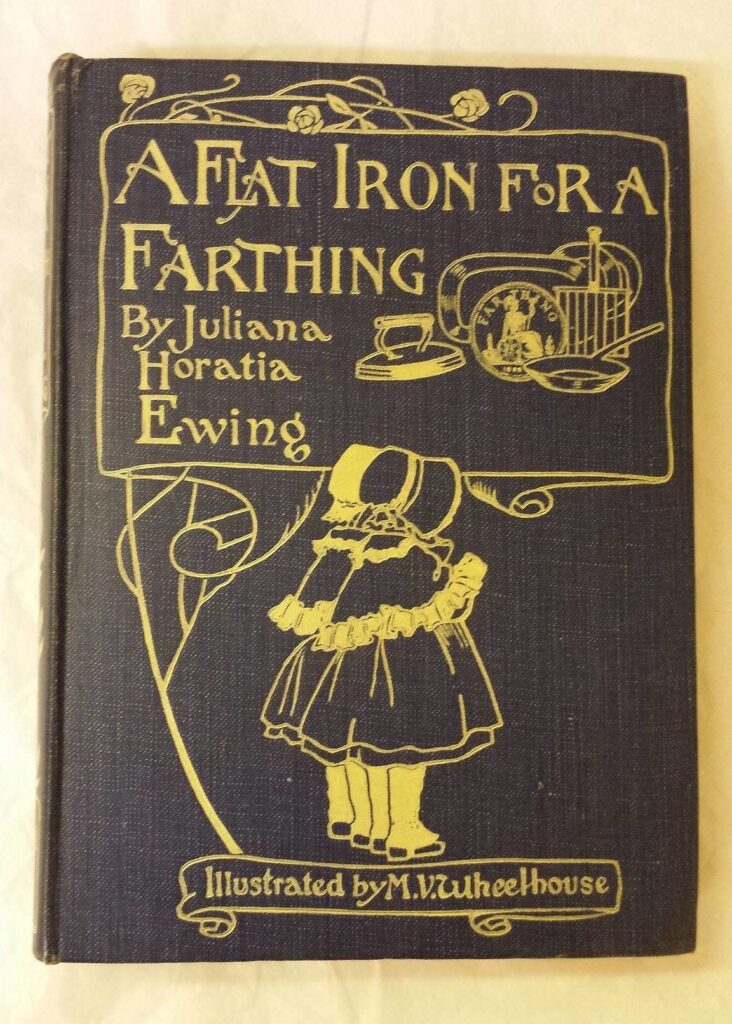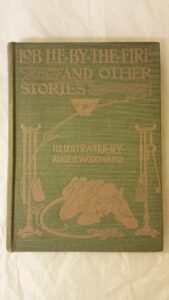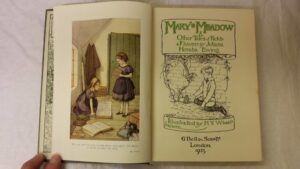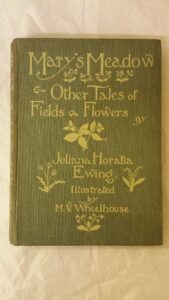One of the authors whose well-thumbed books we frequently discover in the Museum’s long-untouched boxes is Juliana Horatia Ewing. Once a popular and celebrated writer of late Victorian children’s fiction, her achievements – as so often the case with women writers of – have been overlooked. Here, Lois marks Ewing’s importance in the history of children’s literature as well as her influence and inspiration.

In 1853, Reverend John Todd published a conduct book, The Daughter at School, in which he stipulates what good girls ought to read. He writes that:
There are but two kinds of books in the world, – such as are designed to instruct, and such as are intended to amuse; and when a book blends amusement with instruction, it is not for the sake of amusement, but for the sake of instruction, – just as you mix sugar with your medicine, not for the sake of the sugar, but to make the medicine go down.[1]

One writer who arguably achieved both amusement and instruction in her writing was Juliana Horatia Ewing (née Gatty, 1841-1885), who burst into the lives of reading girls in the final three decades of the nineteenth century. Some of her children’s books sold more than one hundred thousand copies during this time period, yet she is still relatively obscure to Victorianists today.[2]
Born in Yorkshire, Ewing’s father was a clergyman and her mother encouraged Juliana and her sister Horatia to write creatively. Juliana was known by many of those closest to her as ‘Aunt Judy’, and she first published most of her fiction in Aunt Judy’s Tales (1859), Aunt Judy’s Letters (1862), and Aunt Judy’s Magazine (1866–82), which her mother edited. After her mother’s death, Juliana became joint editor of the magazine with her sister. In the early 1860s Ewing was also published in The Monthly Packet, the Anglican magazine edited by Charlotte Yonge.
*
The children’s book collection at the Museum of Childhood in Edinburgh holds several of Ewing’s books, as well as one about Juliana’s writerly influence, penned by her sister Horatia Gatty. Ewing died age 44 in 1885, and Horatia released the text for Juliana’s followers. In it she wrote rhapsodically about her sister’s story-writing ability. She likens her to Hans Christian Andersen, and reveals that during her final months, ‘Julie’ wanted more than anything to hear children’s stories, and especially ones told by boy protagonists:
…her appreciation of fun, too, remained keen as ever, and, strange as it may seem, one of the very few books which she liked to have read aloud was Mark Twain’s “Adventures of Huckleberry Finn”; the dry humour of it, – the natural way in which everything is told from a boy’s point of view, – and the vivid and beautiful descriptions of river scenery – all charmed her.[3]

Inspiring stories Her books were well regarded by well-known figures of her day. Rudyard Kipling, for instance, knew one of Ewing’s longer works Six to Sixteen (1872; 1875) almost by heart.[4] The tale is presented as an autobiography of Margery, who describes her orphaned upbringing in India and England. The story must’ve struck a chord with Kipling, who described his difficult childhood in the semi-autobiographical story ‘Baa Baa Black Sheep’, published in 1888. The founder of the scouting movement Robert Baden-Bowell borrowed the name of the young faction of the Girl Guides from Ewing’s story ‘The Brownies’ (1865).
Ewing’s child characters in many ways exemplify a sentimentalised and idealised view of childhood. In Mrs Overtheways’ Remembrances (1866-8; 1869), Ida, the young girl who shyly approaches her old neighbour, the so-called Mrs Overtheways, is ‘a very quiet, obedient little girl as a general rule.’[5] The story explores the innocent potential in children’s curiosity. Another of Ewing’s stories, ‘Jackanapes’ (1869; 1883), features what Horatia calls her ‘forte’ and favourite subject – soldiers. Perhaps unsurprisingly, as her husband was in the military, the story is relentlessly moralistic as well as sentimental. Set in 1815, it tells the story of a boy soldier who dies in battle. ‘Jackanapes’ is also full of literary citations – Lord Byron, Henry Wadsworth Longfellow, George Herbert, John Bunyan, and the German Romantic writer Jean Paul Richter are referred to, which communicates the author’s aspirations for her young readers.
*

Ewing’s texts deserve to be reassessed in light of her huge influence on nineteenth-century children’s fiction. Like many women writers of children’s fiction such as Mary Molesworth and Charlotte Yonge who sold prolifically in the nineteenth century yet have been excluded from the literary canon.
Notes
[1] Reverend John Todd, DD, The Daughter at School (London: T Nelson and Sons, 1853), p. 118.
[2] For more information on Ewing’s life and works, see Philip V. Allingham’s article ‘Juliana Horatia Ewing (1841-1885), Pioneering Late-Victorian Children’s Author — Life and Works’ on The Victorian Web. http://www.victorianweb.org/authors/ewing/bio.html [accessed 3rd May 2017]
[3] Horatia K. F. Gatty, Juliana Horatia Ewing and Her Books (London: Society for Promoting Christian Knowledge, 1885), pp. 78-9.
[4] Susan Drain, ‘Ewing , Juliana Horatia (1841–1885)’, Oxford Dictionary of National Biography (Oxford University Press, 2004) http://www.oxforddnb.com/view/article/9019 [accessed 3 May 2017]
[5] Mrs Overtheways Remembrances, p. 19.
This post written by Lois


